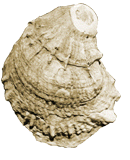![[Chesapeake Quarterly masthead]](/images/uploads/siteimages/imported/masthead.gif)
![[Chesapeake Quarterly masthead]](/images/uploads/siteimages/imported/masthead.gif) |
|
2002
|
Volume 1, Number 1
|
Table of Contents
|
Subscribe
|
Download pdf
|

Disease: An Unexpected CurveOne thing the signers of the 1983 Bay Agreement could not have foreseen was the reappearance, with a vengeance, of a scourge that had first struck the Bay 25 years earlier. During the 1950s, first in Delaware Bay, then in Chesapeake Bay, a mysterious disease appeared, killing thousands and millions of oysters in its path. The nefarious parasite was named MSX (for multinucleated spheres unknown), a moniker as mysterious as its biology. Now known as a haplosporidian (Haplosporidium nelsoni), the parasite has been genetically analyzed, and work by researchers at the Virginia Institute of Marine Science suggests that it is associated with the Japanese oyster, Crassostrea gigas, and probably arrived when experimental populations of the foreign oyster were brought to the Mid-Atlantic region in the 1950s. The appearance of this puzzling oyster disease threw managers, focused on cleaning up "pollution" and restoring oysters, a wicked curve. Many conservationists pointed to environmental factors, such as toxic compounds in the water, that could be stressing the oysters and making them vulnerable to disease. Why else, after thousands of years of thriving in the Bay, would they suddenly begin to die? While toxic compounds may indeed stress oysters, their doom likely shares less with oil-coated birds than with the American chestnut tree. Like the oyster, the chestnut was plentiful in the region, comprising, according to some estimates, about one-third of many forested areas in parts of the Bay watershed. Also like the reef-building oyster, the chestnut played a key ecological role in the region's biological infrastructure, acting as a dominant source of nuts or "mast" for squirrels and other foraging animals. Then, like MSX, the chestnut blight arrived, introduced from Asia. Now, with the coming of warm weather, small oyster spat appear in the Bay and small chestnut shoots appear in the forests. When they reach a certain size, whether spat or shoot, waiting disease strikes them down. How long will it be before current scientific breakthroughs - perhaps with help from nature - devise a way around these two diseases, one of the forest, one of the estuary, both of devastating effect? |
|
Top of Page |
|
|
Home |
Contents |
Other Issues |
|
|
|
||||
![[Maryland Sea Grant]](/images/uploads/siteimages/imported/h_footer_mdsg.gif) ![[NOAA]](/images/uploads/siteimages/imported/h_footer_noaa.gif) |
This page was last modified May 27, 2003 |